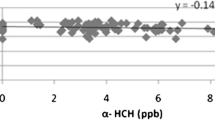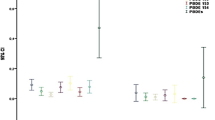Abstract
Organochlorine pesticides (OCPs) were determined by gas chromatography in 241 placentas from cotton-growing regions, 121 placentas from an urban area (city of Osh), and 146 placentas from unpolluted mountain regions of Kyrgyzstan. Manifestations of disease were recorded in the mothers during pregnancy and parturition and in their newborns during the first 6 days of life. OCPs were detected in 240 out of 508 placentas (47.2%), with increased incidence in the two polluted regions (65%), particularly in placentas from women living near former pesticide storehouses and agro air-strips (99%), but only in 2.7% of placentas from the unpolluted region. α-, β-, and γ-hexachlorocyclohexane (HCH); DDT; DDE; aldrin; and heptachlor were detected. The sum of concentrations of all OCPs (total OCPs) was calculated for each of the 240 placentas with detectable OCPs (median 9.5 μg/kg placenta, mean 88.3 μg/kg, range 0.1–3070 μg/kg). The incidence of health problems in four subgroups of this data set, with increasing levels of total OCPs, was compared with the incidence of health problems in the group of 268 placentas, where OCPs were undetectable. Relative risk of health problems in both, mothers and newborns, increased significantly, in a concentration-dependent manner, with increasing levels of total OCPs (p < 0.0001). Health complications with increased incidence in OCP-exposed newborns included, i.a., low birth weight, congenital malformations, infections, and stillbirths, in OCP-exposed mothers preterm delivery, (pre-)eclampsia/gestosis, and frequency of hospitalizations after delivery (infections). Women living near former pesticide storehouses and agro airstrips should be considered as being at risk. Reduction of exposure is urgently needed.
Similar content being viewed by others
References
Aleksandrova LG, Girenko DB, Kalinina AA, Klisenko MA, Korotkova GI, Pismennaya MV, Khokholkova GA, Krivenchuk VE (1992) Guidelines on determination of trace amounts of pesticides in food stuff, biological media, feed and the environment. Part 17. p 389, Moscow. 1988, edited in 1992
Al-Saleh I, Al-Doush I, Alsabbaheen A, Mohamed Gel D, Rabbah A (2004) Levels of DDT and its metabolites in placenta, maternal and cord blood and their potential influence on neonatal anthropometric measures. Sci Total Environ 416:62–74
Al-Saleh I, Alsabbahen A, Shinwari N, Billedo G, Mashhour A, Al-Sarraj Y, Mohamed Gel D, Rabbah A. (2013) Polycyclic aromatic hydrocarbons (PAHs) as determinants of various anthropometric measures of birth outcome. Sci Total Environ. 444:565–578. https://doi.org/10.1016/j.scitotenv.2012.12.021
Amirova Z, Weber R (2015) Massive PCDD/F contamination at the Khimprom organochlorine plant in Ufa—a review and recommendations for future management. Environ Sci Pollut Res Int 22(19):14416–14430. https://doi.org/10.1007/s11356-015-5048-8
Beyond Pesticides (2016) Pesticide-induced disease database. http://www.beyondpesticides.org/resources/pesticide-induced-diseases-database/cancer
Carpenter DO (ed) (2013) Effects of persistent and bioactive organic pollutants on human health. John Wiley & Sons, Inc. All rights reserved ISBN: 9781118679654. https://doi.org/10.1002/9781118679654
Corsini E, Sokooti M, Galli CL, Moretto A, Colosio C (2013) Pesticide induced immunotoxicity in humans: a comprehensive review of the existing evidence. Toxicology 307:123–135. https://doi.org/10.1016/j.tox.2012.10.009
Croes K, Den Hond E, Bruckers L, Govarts E, Schoeters G, Covaci A, Loots I, Morrens B, Nelen V, Sioen I, Van Larebeke N, Baeyens W (2014) Endocrine actions of pesticides measured in the Flemish Environment and Health Studies. Environ Sci Pollut Res Int 22:14589–14599
Dewan P, Jain V, Gupta P, Banerjee BD (2013) Organochlorine pesticide residues in maternal blood, cord blood, placenta, and breastmilk and their relation to birth size. Chemosphere 90(5):1704–1710. https://doi.org/10.1016/j.chemosphere.2012.09.083
Dollimore L, Schimpf W (2013) Obsolete pesticide stocks—the past 25 years, lessons learned and observations for the future. Outlooks Pest Manag 24(6):251–256. https://doi.org/10.1564/v24_dec_04
Doolotkeldieva T, Konurbaeva M, Bobusheva S (2017) Microbial communities in pesticide-contaminated soils in Kyrgyzstan and bioremediation possibilities. Environ Sci Pollut Res Int. https://doi.org/10.1007/s11356-017-0048-5
Hanke W, Jurewicz J (2004) The risk of adverse reproductive and developmental disorders due to occupational pesticide exposure: an overview of current epidemiological evidence. Int J Occup Med Environ Health 17(2):223–243
Jit S, Dadhwal M, Kumari H, Jindal S, Kaur J, Lata P, Niharika N, Lal D, Garg N, Gupta SK, Sharma P, Bala K, Singh A, Vijgen J, Weber R, Lal R (2010) Evaluation of hexachlorocyclohexane contamination from the last Lindane production plant operating in India. Env Sci Pollut Res 18:586–597
Kyrgyz Republic (2006) National Plan for the Stockholm Convention on Persistent Organic Pollutants. 3rd July 2006
Langenbach T (2013) Persistence and bioaccumulation of persistent organic pollutants (POPs). In: Yogesh B. Patil, Prakash Rao (eds) Applied bioremediation—active and passive approaches. ISBN 978-953-51-1200-6, published under CC BY 3.0 license
Lopez-Espinosa MJ, Granada A, Carreno J, Salvatierra M, Olea-Serrano F, Olea N (2007) Organochlorine pesticides in placentas from Southern Spain and some related factors. Placenta 28(7):631–638. https://doi.org/10.1016/j.placenta.2006.09.009
Lysychenko G, Weber R, Gertsiuk M, Kovach V, Krasnova I (2015) Hexachlorobenzene waste deposits at Kalush city (Ukraine)—threat to Western Ukraine and transboundary water bodies and remediation efforts. Environ Sci Pollut Res Int 22(19):14391–14404. https://doi.org/10.1007/s11356-015-5184-1
Mrema EJ1, Rubino FM, Brambilla G, Moretto A, Tsatsakis AM, Colosio C (2013) Persistent organochlorinated pesticides and mechanisms of their toxicity. Toxicol 307:74–88. https://doi.org/10.1016/j.tox.2012.11.015
Nikolaeva LI, Toichuev RM, Leybman EA, Grishechkin AE, Omorbekova CHT, Akhmedova DP, Khametova MS, Rakhimov GM, Yargin SV, Uchaikin VF (2013) Factors affecting the course of chronic hepatitis C in children. Epidemiol Vaccine Prophylaxis 6(73):37–44
Pieterse B, Rijk IJC, Simon E, van Vugt-Lussenburg BMA, Fokke BFH, van der Wijk M, Besselink H, Weber R, van der Burg B (2015) Effect-based assessment of persistent organic pollutant- and pesticide dumpsite using mammalian CALUX reporter cell lines. Environ Sci Pollut Res Int 22(19):14442–14454. https://doi.org/10.1007/s11356-015-4739-5
Revich B, Shelepchikov A (2008) Persistent organic pollutants (POPs) hot spots in Russia. In: The Fate of Persistent Organic Pollutants in the Environment NATO Science for Peace and Security Series 2008. pp 113–126
Toichuev RM (2007) Medical and environmental issues of southern Kyrgyzstan. Central Asian Journal of Medicine. The 3rd National Congress on Respiratory Diseases, April 19–21, 2007 Osh, Kyrgyzstan, vol 13 Annex 1, 2007, pp 22–25
Toichuev R.M., Tostokov E.T. (2006) Influence of organochlorine pesticides (OCPs) in the development of congenital tumors in children. Proceedings of the V Russian Congress “Modern technologies in pediatrics and pediatric surgery.” M .: “Overlay”, 2006, P. 315
Toichuev RM., Kudaiberdieva Ch, Kaparova M. (2007) Alterations in liver function tests in children involved in cotton cultivation. Russia, Proceedings of the VI Russian Congress “Modern technologies in pediatrics and pediatric surgery”, 23–25 October 2007, pp 209–210 (in Russian)
Toichuev R.M, Tostokov E., Joldoshov S., Argynbaeva A. (2012) The effect of organochlorine pesticides (OCPs) on the prevalence of hepatitis in children. ISEE 2012, 26–30 August, Columbia, South Carolina (USA).
Toichuev RM, Leybman E, Omorbekova C, Rakhimova G, Zhumabek Kyzy B, Nikolaeva L (2014) Childhood hepatitis in Osh Province of southern Kyrgyzstan. Euroasian J Hepato-Gastroenterology 4(2):117–118
Toichuev RM, Zhilova LV, Makambaeva GB, Payzildaev TR, Pronk WL, Bouwknegt MA, Weber R (2017) Assessment and review of organochlorine pesticide pollution in Southern Kyrgyzstan. Environ Sci Pollut Res Int. https://doi.org/10.1007/s11356-017-0001-7
Tyagi V, Garg N, Mustafa MD, Banerjee BD, Guleria K (2015) Organochlorine pesticide levels in maternal blood and placental tissue with reference to preterm birth: a recent trend in North Indian population. Environ Monit Assess 187(7):471. https://doi.org/10.1007/s10661-015-4369-x
UNEP (2006) Enabling activities for preparation of the National Implementation Plan of the Kyrgyz Republic for the Stockholm Convention on POPs. Bishkek, 2006. p 82. GEF Project No. GEL-2328-2971-471 4
Vijgen J, Abhilash PC, Li Y-F, Lal R, Forter M, Torres J, Singh N, Yunus M, Tian C, Schäffer A, Weber R (2011) HCH as new Stockholm Convention POPs—a global perspective on the management of Lindane and its waste isomers. Env Sci Pollut Res Int 18(2):152–162. https://doi.org/10.1007/s11356-010-0417-9
Vijgen J, Aliyeva G, Weber R (2013) The forum of the International HCH and Pesticides Association—a platform for international cooperation. Env Sci Pollut Res Int 20(4):2081–2086. https://doi.org/10.1007/s11356-012-1170-z
Weber R, Gaus C, Tysklind M, Johnston P, Forter M, Hollert H, Heinisch H, Holoubek I, Lloyd-Smith M, Masunaga S, Moccarelli P, Santillo D, Seike N, Symons R, Torres JPM, Verta M, Varbelow G, Vijgen J, Watson A, Costner P, Wölz J, Wycisk P, Zennegg M (2008) Dioxin- and POP-contaminated sites—contemporary and future relevance and challenges. Env Sci Pollut Res Int 15(5):363–393. https://doi.org/10.1007/s11356-008-0024-1
WHO (2013) Contaminated sites and health. Report WHO Regional Office for Europe, Copenhagen
Yablokov AV (1988) Pesticides, environment, agriculture. Zhurnal “Kommunist” 15:34–42. (in Russian)
Acknowledgements
The authors are indebted to Medicine-Yug LLC for the financial support.
Author information
Authors and Affiliations
Corresponding authors
Additional information
Responsible editor: Philippe Garrigues
Rights and permissions
About this article
Cite this article
Toichuev, R.M., Zhilova, L.V., Paizildaev, T.R. et al. Organochlorine pesticides in placenta in Kyrgyzstan and the effect on pregnancy, childbirth, and newborn health. Environ Sci Pollut Res 25, 31885–31894 (2018). https://doi.org/10.1007/s11356-017-0962-6
Received:
Accepted:
Published:
Issue Date:
DOI: https://doi.org/10.1007/s11356-017-0962-6




